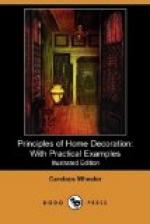It is the fascination of this study which has made a multiplication of shops and collections of “antiques” in every quarter of the city. Many a woman begins from the shop-keeper’s point of view of the value of mere age, and learns by experience that age, considered by itself, is a disqualification, and that it gives value only when the art which created the antique has been lost or greatly deteriorated. If one can find as good, or a better thing in art and quality, made to-day—by all means buy the thing of to-day, and let yourself and your children be credited with the hundred or two years of wear which is in it. We can easily see that it is wiser to buy modern iridescent glass, fitted to our use, and yet carrying all the fascinating lustre of ancient glass, than to sigh for the possession of some unbuyable thing belonging to dead and gone Caesars. And the case is as true of other modern art and modern inventions, if the art is good, and the inventions suitable to our wants and needs.
Yet in spite of the goodness of much that is new, there is a subtle pleasure in turning over, and even in appropriating, the things that are old. There are certain fenced-in-blocks on the east side of New York City where for many years the choice parts of old houses have been deposited. As fashion and wealth have changed their locality—treading slowly up from the Battery to Central Park—many beautiful bits of construction have been left behind in the abandoned houses—either disregarded on account of change in popular taste, or unappreciated by reason of want of knowledge. For the few whose knowledge was competent, there were things to be found in the second-hand yards, precious beyond comparison with anything of contemporaneous manufacture.
There were panelled front doors with beautifully fluted columns and carved capitals, surmounted by half-ovals of curiously designed sashes; there were beautifully wrought iron railings, and elaborate newel-posts of mahogany, brass door-knobs and hinges, and English hob-grates, and crystal chandeliers of cost and brilliance, and panelled wainscots of oak and mahogany; chimney-pieces in marble and wood of an excellence which we are almost vainly trying to compass, and all of them to be bought at the price of lumber.
These are the things to make one who remembers them critical about the collections to be found in the antique shops of to-day, and yet such shops are enticing and fashionable, and the quest of antiques will go on until we become convinced of the art-value and the equal merit of the new—which period many things seem to indicate is not far off. In those days there was but one antique shop in all New York which was devoted to the sale of old things, to furniture, pictures, statuary, and what Ruskin calls “portable art” of all kinds. It was a place where one might go, crying “new lamps for old ones” with a certainty of profit in the transaction. In later years it has been known as Sypher’s, and although one of many, instead of a single one, is still a place of fascinating possibilities.




